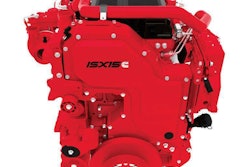
The so-called Phase 2 of the Greenhouse Gas Emissions Standards and Fuel Efficiency Standards for Medium- and Heavy-Duty Engines and Vehicles yielded hundreds of thousands of comments, with trucking industry stakeholders mostly saying they agree with the purpose of the regs — cleaner air — but see flaws in the EPA’s massive rule.
The proposed standards would begin in model year 2018 for trailers and 2021 for tractors and culminate in vehicle-wide — engine, truck and trailer — standards for model year 2027 vehicles.
Trailer manufacturers, engine manufacturers and several trucking associations submitted comments during the comment period, summaries of which can be seen below:
American Trucking Associations: ATA said the market penetration rates estimated in the proposed rule are “overly aggressive,” and that OEMs “will be facing an uphill battle from the start in meeting their targets.”
ATA also said it believes the EPA and NHTSA underestimated the costs of technologies, “making the payback period on these technologies much longer than is stated in the proposed rule.”
Paccar (Peterbilt and Kenworth parent company): Paccar, parent company of Peterbilt and Kenworth, said the EPA and NHTSA should provide credits for advanced/innovative technologies. The company said it believes the “concept of credits helps promote innovation by incentivizing manufacturers to go beyond traditional research, development and marketing programs.”
Some technologies Paccar suggests giving credits for include speed limiters, B-20 capability, tire pressure monitoring, hybrid technology multipliers, rear axle efficiency, transmission efficiency and more.
Navistar: Navistar said it has “significant concerns” with the proposed Phase 2 rules. It said if changes aren’t made to the proposed rule, it “would not only cause disruption and heavy costs to the industry, but would also actually set back the goal of environmental improvements.”
The company said the three tiers of emissions standards in 2021, 2024 and 2027 will be the minimal lead time required to have engines built to meet the GHG regulations.
“There is a significant risk that the industry will be in nearly continuous development from 2019 through 2027,” Navistar stated. “The result of this complexity will be added costs.”
Navistar added that from a consumer view, there could be additional costs and potential downtime as new technologies emerge.
Daimler: Freightliner parent company Daimler lists several things it believes the EPA and NHTSA need to do in order for Phase 2 to work.
Daimler said the agencies have to resolve problems with aerodynamic test procedures and binning, “as the problems make the agencies’ proposed standards impossible;” correct unrealistic technology Fuel Consumption Reduction values and penetration rates for technologies used in standard settings; credit cost-effective fuel saving technologies; allow for reasonable lead time and stability; and more.
Volvo: Volvo said it feels the rule, as currently written, is “unworkable,” but supports the overall goal of it.
Volvo said a single national rule is “imperative,” stating California should not have separate standards than the rest of the U.S.
The company also said it believes there could be potential problems that won’t surface until the regulations are fully implemented, and that it’s important that the regulations “deliver the expected in-use performance.”
“Because of the strong financial impact of fuel efficiency on commercial fleet operations, the actual results of efficiency regulation will be closely measured and monitored by fleet owners. If the required technologies do not deliver expected fuel savings at an affordable cost, or result in excessive maintenance and down-time, fleets will not purchase vehicles. Instead, they will repair and rebuild their existing vehicles as they have increasingly done, due to costs and operational problems from recent emissions technologies.”
Cummins: Cummins said it believes “market demand will drive performance that meets or exceeds the proposed engine standards, and the technologies will be available.”
The company added that it agrees with the EPA and NHTSA that waste heat recovery technology will be viable to comply with the standards for tractor engines. Cummins said it expects WHR systems to be commercially viable and available as early as 2020.
Great Dane: Trailer manufacturer Great Dane said it supports reductions in GHG emissions and improved energy efficiencies, but said trailer designs and specifications “vary widely from customer to customer and even within a given customer’s fleet based on their operational needs.”
In reference to the possibility of low rolling resistance tires, Great Dane said it supports the use of these technologies to save fuel and reduce emissions, but added that since it doesn’t “directly operate trailers in revenue service, [it] cannot offer firsthand information on the tradeoffs associated with these technologies.”
Great Dane also said it has customers who have said low rolling resistance tires and automatic tire inflation systems don’t meet their expectations, so they don’t order them on their trailers.
The company also commented on trailer aerodynamics and said it believes food service trailers should be exempted from trailer aero requirements because the equipment on these trailers would hinder cost-effective aero use. Great Dane also added it believes regulations forcing the use of rear trailer aero devices won’t result in cost-effective deployment of the devices.
The company concluded that the trailer OEM and the fleet are “best qualified to determine the practicality of the use of a particular device.”
Wabash National: Wabash, similarly to Great Dane, said it supports the goals and objectives of the Phase 2 proposed rule to reduce GHG emissions.
Wabash said that while it’s not in opposition to LRRTs or ATIS’, the company does state it’s concerned with the suppliers of these technologies and their ability to keep up with the increased demand that will come with these regulations.
The company also stated the EPA “severely underestimated the costs” for trailer manufacturers implementing these new standards because, Wabash said, the EPA used 2009 Bureau of Labor statistics to estimate labor costs, rather than the current version of those estimates. Wabash said the 2009 numbers were outdated when the EPA ran its numbers.
Utility Trailer Manufacturing Company: Utility also said market forces will achieve most of the benefits of the proposed rules with fewer costs, because, it said, “if technological advances exist that will permit the transporters to move their goods more efficiently at lower costs, they will require the manufacturers to supply those advances.”
Like Wabash, Utility also said it believes the EPA underestimated the cost of the mandated technologies.
Utility also said the real-world savings from these technologies won’t meet the expectations laid out in the proposed rule.
Owner-Operator Independent Drivers Association: OODIA said it’s concerned that the EPA and NHTSA “have not accurately estimated the costs and benefits of the proposed rule, nor have they adequately considered the excessive burden that will be placed upon small business owners and professional truck drivers from exorbitantly expensive, untested, and in some cases unproven technologies.”
OOIDA said it believes the market should drive fuel-efficient technologies “instead of expensive mandates.”
The association also said “fuel economy” is not an accurate measuring stick with heavy-duty vehicles because so many factors influence a truck’s fuel economy, such as freight hauled, route, traffic, speed limits, driver skill and more.
California Trucking Association: CTA said it supports ATA’s comments on the proposed rule, and added that there is a need for harmonization with California.
“Given the interstate nature of trucking, national consistency in regulatory approaches is critical,” CTA stated. “We strongly urge EPA/NHTSA to continue to work with the California Air Resources Board to ensure a unified, national truck program.”











